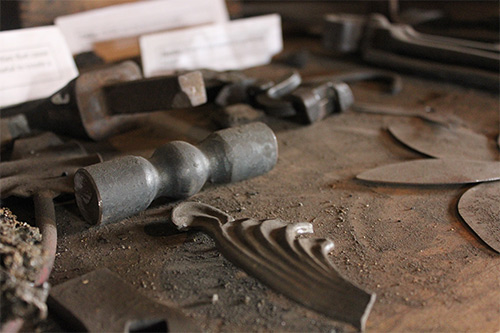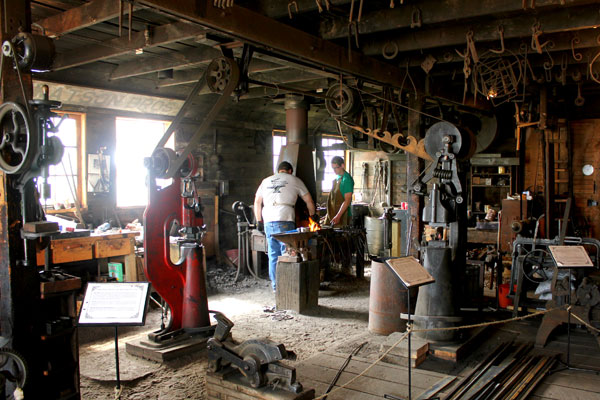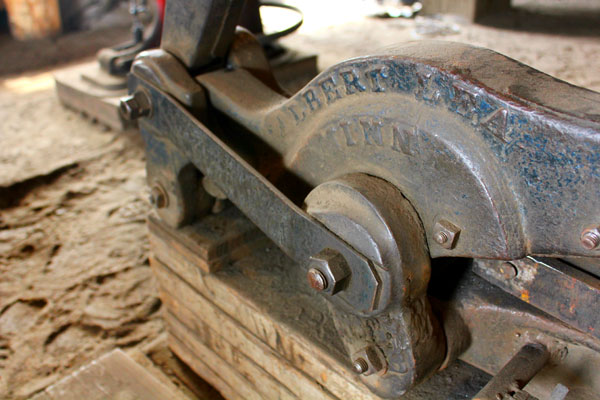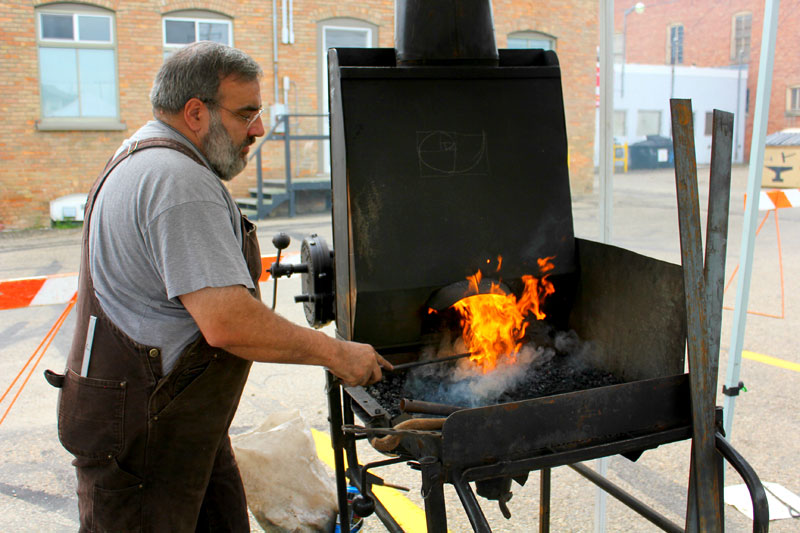Open Farm Days is a two-day agricultural celebration where farms and businesses across Alberta open their doors to the public. In 2016, many Central Alberta locations took part in the festivities. Here’s a look at one particular experience…
Walking into the century-old Lacombe Blacksmith Shop Museum is like stepping into a time-capsule to 1902 Central Alberta. The Museum – which is located on the original shop site, is full of antique equipment, operational tools, trade artifacts and years of Alberta blacksmithing traditions.
A Trade Passed Down Through Generations
Around the side of the museum, we meet a group of volunteers on their lunchbreak in what they refer to as “Blacksmith Alley” – a setup of several coal and propane forges. Past the group of men, we notice one man in particular, wearing well-worn overalls and covered in coal ashes tidying his work station. His tool box catches our eyes. It’s filled with unique archaic tools, and we ask for a photo. Scott kindly lets us take the photograph while he quietly gathers his tools. As we begin asking questions regarding blacksmithing, it’s clear to see he’s extremely passionate about this unique, one of a kind trade. He is quick to rekindle his stoked fire to show us how some of the tools work and discuss their history, as well as what it means to be a blacksmith in the past and present day. Scott has been a blacksmith for over twenty years and says he was fortunate to have the knowledge passed down to him from generations before.
We start to take a picture of some of the equipment when Scott stops us. Smiling, he grabs a tool and says we probably wouldn’t want the modern equipment in the photo – but he has to carry it. It’s interesting to see that although blacksmithing largely hasn’t changed over the years – the small improvements made in modern times are vital. Blacksmithing is one of the oldest trades, and the Lacombe Blacksmith Shop was once a bustling hub in the days of horse and buggies. As the trade has been passed down from generation to generation, so too has much of the equipment. Scott points to each of the anvils being used by blacksmiths around us and enthusiastically names the make, age and country of origin of each. His eagerness to explain the work he so passionately does is reflective of the agricultural community. At the heart of Open Farm Days, there is a desire for those in related industries to share their stories and show the work they love to their urban and rural neighbours.
Scott explains the process of how he heats up the forge by creating moving air directly below the coal. Scott says it’s kind of like how you blow on a campfire to create heat. The forge reaches a temperature between 1600 and 1800 F, however, because the heat is centralized from below, the steel only heats up in the area that the blacksmith wants and Scott can still hold the piece of metal.
He pulls the red-hot steel from the forge and begins to shape it on his anvil, pounding it with a hammer. The process is slow and tedious but you can tell from Scott’s passion that it’s rewarding work.
A Close-Knit Community
In this particular case, there is extra motivation for the work. During Alberta Open Farm Days, the Lacombe Blacksmith Shop Museum hosted a special Hammer-In event where they invited blacksmiths from across Alberta to build two benches to support their fellow Albertans in Fort McMurray. One bench will be given to the community affected by the wildfires earlier in the year. The other will be auctioned off at the Lacombe Culture & Harvest Festival on September 24th, 2016. All proceeds from the sale of the bench will be given to the Canadian Red Cross to go towards the rebuilding efforts.
This community building effort is engrained into the culture of blacksmithing and agricultural trades across Alberta. Scott talks about how blacksmithing is a very close-knit community where members of different guilds throughout Alberta know each other well. During the summers, Scott fills his time with demonstrations across the the province and often meets up with fellow blacksmiths. He told us many stories of how different generations meet through demonstrations and events such as Open Farm Days and how it gives them an opportunity to share their skills and discuss their passion together.
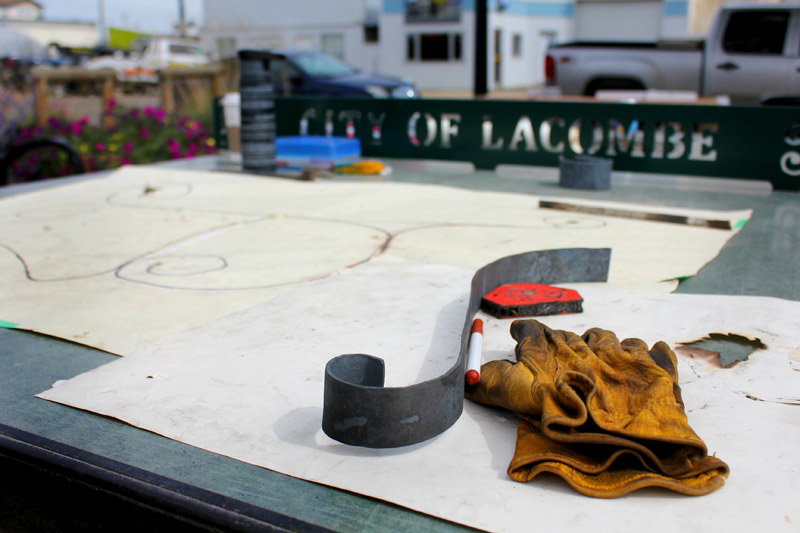
The Mark of a Good Blacksmith
While accuracy, strength and knowledge are all important components of the trade – Scott tells us that the real mark of a good blacksmith is their ability to problem solve. He tells us that he was once at a demonstration when a man in a nice old car pulled up. His gearshift was not working properly, and he wasn’t sure what to do. Scott took a quick look at it and built the replacement piece during the demonstration. He said the man drove off in amazement over the fact that he could create a new part on the spot, but that’s what a blacksmith loves to do – look at something, figure out how the different parts work and find a solution to a given problem. Scott mentions that a lot of blacksmithing tools are created by the blacksmith to solve a specific problem. Thinking on your feet and working with what you have is crucial to the blacksmithing community. This speaks well to members in the Alberta agriculture community – they too must problem solve and work with what they have. The unpredictable Alberta weather, fluctuating prices and other circumstances outside of their control affect their line of work directly – it’s adaptability and the ability to problem solve that is the mark of a good agricultural tradesperson.
Before arriving at this Open Farm Days location, we had little knowledge of the blacksmithing world. By talking with Scott and exploring the Museum, we left feeling appreciative to all that blacksmithing has given to society. It showcased the boundless skills that blacksmiths have which enabled them to shape the past and continue to contribute to our future.
Other Blog Articles
Explore Central Alberta
-
November 15, 2019
Chill Like A Local: Winter Adventures in Central Alberta
As the temperature dips and the frost begins to accumulate on the ground, there’s one thing likely to be on your mind: its time to get out and explore! Winter comes alive in Central Alberta and below we outline a few examples of how you can experience it. Festive Festivities Markets, town light ups, festivals, […]
-
August 7, 2019
Relive Like a Local: Visit Central Alberta’s History
Heritage isn’t just memory, it’s culture. See the vibrant buildings, murals, parks, and art throughout Central Alberta’s communities. See it, touch it, and experience it all first hand as you make your way through the region.
-
August 3, 2019
Trek Like A Local: Hiking & Horses Through Central Alberta’s Trails
Over 3200km of trails map Central Alberta’s landscape in both urban and rural municipalities. From the mountains to the grass sea, the region shines as the destination for hiking and horse riding.

